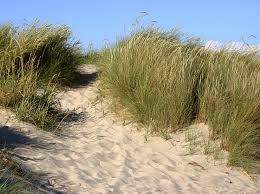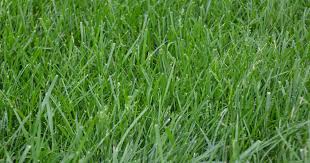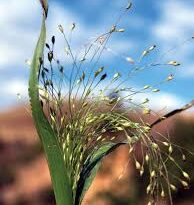Everything You Need To Know About Beach Grasses (Coastal Grass)
Beach grass is a special kind of plant that grows on sandy parts near the ocean, like beaches. You might also hear it called coastal or dune grass. This plant is pretty important because it helps keep the beach and the land close to it safe.
You know how the wind can be really strong at the beach, and how the waves can crash onto the shore? Well, beach grass helps deal with these things. It has long and skinny leaves that catch sand and build up big mounds of it. These mounds are called dunes. Dunes are like natural walls that stop the wind and waves from moving the sand away. They’re like a protective barrier for the land behind them.
Beach grass is really good at living in tough beach conditions. Its roots grow really deep into the sand, which stops it from getting pulled out by the wind or water. These roots also help the grass get water and food from deep down in the sand, because sandy soil doesn’t hold water very well.
But beach grass isn’t just useful, it’s also pretty. When you look at a beach covered with this grass, it adds a nice touch to the view. The leaves sway in the breeze, and the tops of the grass have these special parts that make seeds. These seeds spread and grow into new grass, helping to keep the beach healthy.
Remember, when you visit the beach, try not to walk on the dunes where the beach grass is. Dunes are sensitive, and the grass needs them to survive. Many places have rules to protect the dunes, so it’s a good idea to follow them.
The next time you’re at the beach, take a moment to think about how this simple-looking grass is actually doing a big job to help the beach and the environment around it stay safe and beautiful.
Read Also: Everything You Need To Know About Grasscutter
Growing and Care Guide of Beach Grass

Beach grass, also known as coastal or dune grass, can be a wonderful addition to coastal environments. Whether you’re looking to help stabilize sand dunes, prevent erosion, or simply enhance the natural beauty of your property, growing beach grass can be a rewarding endeavor.
Here’s a step-by-step guide to help you successfully grow and care for beach grass:
1. Choosing the Right Location: Select a spot along the coast where you want to grow beach grass. Look for areas with sandy soil and plenty of sunlight. Beach grass is adapted to these conditions and will thrive best in such environments.
2. Obtaining Beach Grass: You can either collect beach grass seeds from existing plants on the beach (if allowed by local regulations) or purchase seeds from nurseries or online stores. Make sure you’re using native beach grass species that are suited for your region.
3. Planting:
a. Prepare the soil: Loosen the sandy soil where you plan to plant the beach grass. Remove any debris or weeds.
b. Sow the seeds: Scatter the seeds evenly over the prepared soil. You don’t need to bury them deep; just press them gently into the sand.
c. Water: Water the area lightly after planting to help the seeds settle into the soil.
4. Watering: Initially, keep the soil consistently damp until the grass starts to sprout. Once the grass is established, you can reduce the frequency of watering. Beach grass is used to growing in sandy soil, so avoid overwatering, as excess moisture can lead to problems.
5. Fertilizing: Beach grass doesn’t require much fertilization. If you feel the need to provide nutrients, use a slow-release, balanced fertilizer during the growing season, but avoid over-fertilizing, as it can harm the delicate balance of the ecosystem.
6. Pruning: Trim dead or damaged leaves and stalks as needed. This helps keep the plant healthy and encourages new growth.
7. Preventing Disturbance: It’s important to minimize foot traffic on the newly planted or established beach grass areas. Walking on the grass can damage the roots and hinder its ability to protect the shoreline.
8. Monitoring and Care: Regularly inspect your beach grass for signs of pests, diseases, or stress. If you notice any issues, address them promptly. Also, be mindful of any local regulations regarding planting and care of beach grass.
9. Long-Term Maintenance: As the beach grass matures, it will continue to help stabilize the sand and protect against erosion. Keep an eye on the health of the grass and make any necessary adjustments to your care routine.
Growing beach grass requires patience and commitment, but the benefits it brings to the coastal environment are worth it. By following these steps and giving your beach grass the attention it needs, you’ll be contributing to the preservation of the delicate balance between land and sea while enjoying the beauty it brings to the beach landscape.
Read Also: Introduction to Poultry Farming
Benefits of Beach Grass

Here are nine wonderful reasons highlighting the importance of beach grass:
1. Erosion Prevention: Beach grass plays a vital role in preventing erosion along coastlines. Its root system helps anchor sand and create dunes, acting as a natural barrier against the powerful forces of wind and waves.
2. Coastal Stabilization: By building up dunes, beach grass helps stabilize coastal ecosystems. These dunes act as buffers, absorbing the energy of storms and protecting nearby properties, roads, and infrastructure from damage.
3. Habitat Creation: Dunes created by beach grass serve as habitats for various plant and animal species. They provide nesting sites for shorebirds, insects, and other creatures, contributing to the biodiversity of coastal environments.
4. Carbon Sequestration: The root systems of beach grass help trap carbon dioxide from the atmosphere and store it in the soil. This process contributes to mitigating the effects of climate change by reducing greenhouse gas concentrations.
5. Sand Dune Formation: Over time, beach grass helps build up sand dunes, which become important natural features. Dunes protect inland areas from saltwater intrusion and provide spaces for unique plant communities to thrive.
6. Beach Nourishment: As beach grass stabilizes sand, it helps retain sediment, which in turn contributes to natural beach nourishment. This process maintains the health and size of beaches, benefiting tourism and recreation.
7. Aesthetic Value: The swaying leaves and distinctive seed heads of beach grass add to the visual beauty of coastal landscapes. Their presence enhances the natural charm of beaches and creates a serene atmosphere.
8. Education and Awareness: Beach grass serves as a tangible example of the delicate balance between nature and human activity. Its importance can help educate people about the significance of preserving coastal ecosystems and respecting local regulations.
9. Cultural Significance: In addition to its ecological benefits, beach grass holds cultural importance. It’s a symbol of the coast, inspiring art, literature, and traditions. Many communities recognize the value of beach grass in preserving their way of life.
These nine points underscore the essential role that beach grass plays in maintaining the health and vitality of coastal regions. From protecting against erosion to supporting local wildlife and even influencing cultural identities, beach grass stands as a testament to the interconnectedness of nature and human well-being.
Read Also: Relationship Marketing Process and Approaches to the Study of Marketing









